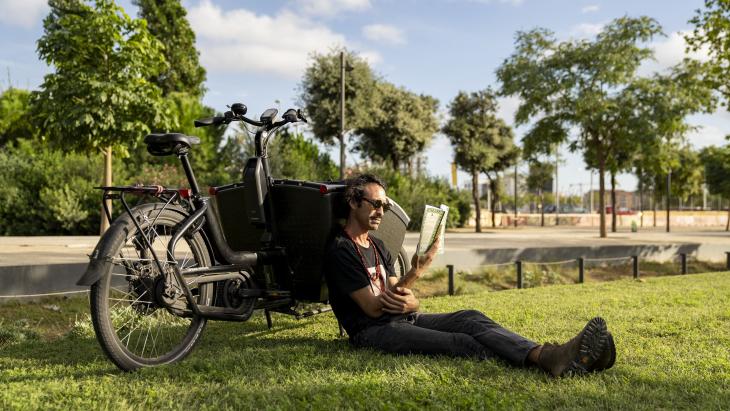Points of interest in the city
Literary Barcelona

A city in novel
There are many, many novels that transport the reader to Barcelona. Throughout literary history, the city has been portrayed by countless writers from around the world: Miguel de Cervantes, Hans Christian Andersen, George Orwell, to name but three. However, authors who were actually born in the Catalan capital are, perhaps, those that have best described the city, creating authentic Barcelonan characters that guide us around its nooks and crannies. Reading about the domains of these characters takes us on a literary tour in which we explore the city from end to end.
A literary muse
Barcelona abounds in literary settings. The city is the protagonist of many bestselling novels, such as: Eduardo Mendoza’s City of Prodigies, which describes life in the Catalan capital during the years between two world’s fairs and between the Ciutadella Park and Montjuïc; Carlos Ruiz Zafón’s The Shadow of the Wind, which submerges the reader in a Ciutat Vella world of books and bookshops; and Cathedral of the Sea, by Ildefonso Falcones, which narrates the construction of the Basilica of Santa Maria del Mar in the fourteenth century. Moreover, several of the city’s neighbourhoods are closely linked to writers who were born and lived in them. In numerous works, authors transform the city into the personal universe of the characters they create.
El Raval
In The Thief’s Journal, the French writer Jean Genet, to whom a square in the Raval neighbourhood is dedicated, provides the reader with a sketch of Barcelona’s Barri Xino (“Chinatown”) in the 1930s. Not long after this, three writers were born, all of whom fascinated their readers with descriptions of the worlds they grew up in. Manuel Vázquez Montalbán transformed the neighbourhood of his youth into the setting for many crime novels featuring the detective Pepe Carvalho whilst, as a food critic, the writer also popularised such restaurants as Casa Leopoldo and Ca l’Isidre. Film buff and author Terenci Moix underwent a sexual awakening in a Barcelona neighbourhood in the mid-twentieth century, penning his memoirs in El pes de la palla, a trilogy whose title alludes to the square of the same name, which adjoins Ronda de Sant Antoni. Maruja Torres sets the childhood of the central character in her novel Un calor tan cercano in Carrer de la Unió, although the writer describes herself as a child of El Raval who later became a lady of the Eixample district.
A feminine Eixample
Women, precisely, are those that have best portrayed Barcelona’s Eixample district. That is exactly what Carmen Laforet did in her novel Nada, in which Plaça de la Universitat and Carrer d’Aribau are the starting points for an exploration of the entire city. A similar case is that of Mercedes Salisachs, whose novel La gangrena portrays the bourgeois society that inhabits the Eixample. However, it was Montserrat Roig above all who described the denizens, landscapes and interiors of the district in her prolific work. Roig even explores the history of the neighbourhood in her book Digues que m’estimes encara que sigui mentida.
From Gràcia to Guinardó
Another woman writer, Mercè Rodoreda, turned Gràcia into one of the city’s most emblematic literary terrains when she made Plaça del Diamant the centre of the universe inhabited by Natalia, La Colometa, her most beloved character. Rodoreda went on to elevate Carrer de les Camèlies, in the nearby Guinardó neighbourhood, to classical status in Catalan literature by naming another of her novels after the street.
Rodoreda shares these neighbourhoods with another Barcelonan writer who has done much to portray the city to the world: Juan Marsé. In his many works, Marsé’s characters move around the Guinardó, Gràcia, La Salut and El Carmel neighbourhoods, stopping at typical local sites. Bar Delicias on Carretera del Carmel, where Pijoaparte killed time in Últimas tardes con Teresa, is, without doubt, the finest spot at which to appreciate the different settings used by this popular writer.
Poetry in the city heights
Sarrià - Sant Gervasi district is another literary goldmine, the birthplace and home of such outstanding authors as the Goytisolo brothers—novelists and essayists Juan and Luis, and poet José Agustín—and poets like Joan Maragall, Jaime Gil de Biedma, Joan Brossa, Joan Margarit and Joan Vinyoli. Moreover, several sites in local parks and gardens, such as Turó Park, Turó del Putxet and Monterols, have provided inspiration and settings for poems that suggest a most lyrical route around the area.
However, if we are really to make our sweet way around the streets of the old Sarrià neighbourhood, we should do so with Josep Vicenç Foix, the son of local pastry-makers who, whilst working in the kitchens, became the most outstanding Catalan avant-garde poet. The Foix de Sarrià cake shop, which now has two branches in the neighbourhood, is a veritable institution in Sarrià and a place of pilgrimage for lovers of delicious sweets and the finest letters. Vázquez Montalbán used to stop off there on his way to his home in Vallvidrera. The writer, originally from El Raval, not only established his residence in this neighbourhood of detached houses in the midst of the Collserola hills during his mature years, but also made it the home of his most famous creation, the detective Pepe Carvalho. Vázquez Montalbán is our ideal guide to the viewpoints along Passeig de les Aigües that command superb vistas over a literary city in constant transformation.

